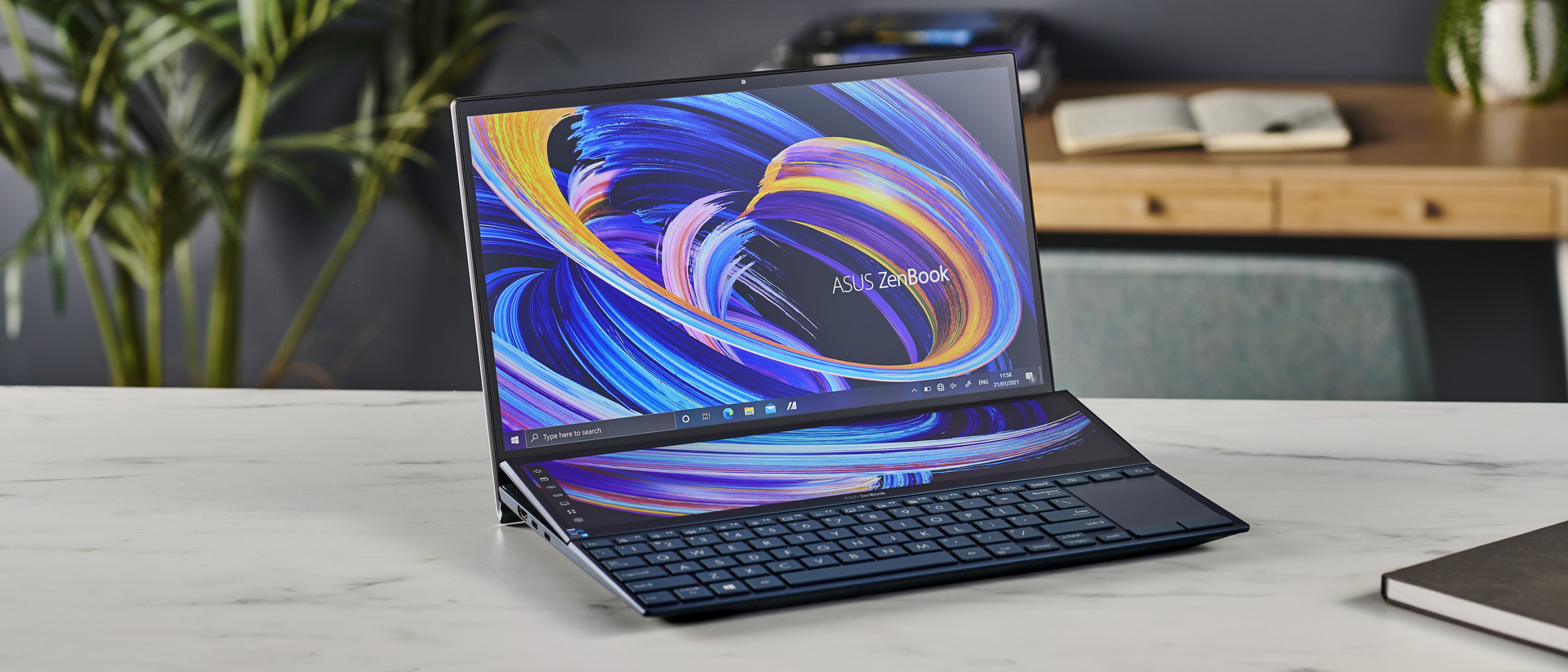TechRadar Verdict
The Asus ZenBook Duo 14 UX482E is the company's latest dual-screen laptop. To Asus' credit, it's worked hard to ensure that the second screen is more than a mere curio, and it's now more useful and customizable than ever. New 11th-gen Intel processors, plenty of RAM and a sleek design make this a brilliant premium laptop, but it won't be for everyone.
Pros
- +
ScreenPad Plus is better
- +
Slim and light design
- +
Great performance
- +
Very good battery
Cons
- -
Keyboard placement is awkward
- -
Some models aren't available in certain markets
- -
ScreenPad Plus still isn't for everyone
Why you can trust TechRadar
Two-minute review
The Asus ZenBook Duo 14 UX482E, announced at CES 2021, is the latest dual-screen laptop from the company, which seems determined to make a case for a second screen on a laptop.
Previous ZenBook Duos, plus the gaming-oriented Asus Zephyrus Duo 15 GX550, have hinted at the possibilities of the use of a second screen, but while we appreciated Asus trying something different with the laptop form factor, the second screen on those devices have never felt essential. With the ZenBook Duo 14 UX482E, Asus is hoping to change that.
And the company starts by ensuring it doesn’t feel like you’re having to pay much extra for the second screen.

The base model offered in the UK differs, however. It's more expensive at £1,499 (around $2,000, AU$2,600) and comes with an Intel Core i7-1165G7 processor, Nvidia MX450 graphics card, 16GB of RAM and 512GB SSD.
That’s quite a big price jump for UK buyers, and while it offers a step up when it comes to power, there's no option for those looking for a more affordable laptop with more modest specs in the UK, which is a shame. Hopefully that changes in the near future.
As far as that second screen is concerned, Asus has also done a superb job of ensuring it hasn't resulted in a bulky laptop. The design is impressively svelte, and the ZenBook Duo 14 UX482E boasts the kind of build quality we’ve come to expect from the company. This looks and feels like a premium laptop.
The second screen – or ScreenPad Plus – is the most noticeable feature of the design, adding a 12.65-inch touchscreen with a 1,920 x 515 resolution below the main 14-inch 1080p screen.
Sign up to the TechRadar Pro newsletter to get all the top news, opinion, features and guidance your business needs to succeed!
Thanks to the thin bezels around the screen, moving between the top and bottom displays feels pretty seamless, plus it’s large enough to present windows such as email clients.
The position of the second screen does mean that the keyboard has been moved down to the front of the bottom-half of the laptop. This may in fact prove the most contentious aspect of the ZenBook Duo 14 UX482E’s design, since it takes a bit of getting used to. It means you’ll probably want to use a wrist-rest when typing, which will lead you to having to use the laptop on a table or desk.
Nevertheless, Asus has worked hard to make the ScreenPad Plus more useful, with an increasing number of third-party apps now supporting the screen. You can now also easily configure it to work with apps that don’t have included support, and with a bit of tweaking you can get the second screen to behave the way you want it to.
The rest of the performance of the ZenBook Duo 14 UX482E is excellent thanks to a series of powerful, modern mobile components. This is an Intel Evo-certified laptop, so not only does it pack the latest Intel Core 11th-generation processors, it also wakes up from sleep quickly, and its battery lasted almost 12 hours in our test – pretty impressive for such a powerful laptop.
Overall, the Asus ZenBook Duo 14 UX482E is a premium laptop that delivers excellent performance and superb battery life. Its thin and light design hasn't resulted in a bulky and cumbersome device – and, to Asus’ credit, it’s continued to work hard to make the ScreenPad Plus a useful tool, rather than a gimmick. While the majority of users will still be fine with a single screen laptop, creative professionals and content creators may find the ScreenPad Plus a genuine positive that helps speed up their workflow.
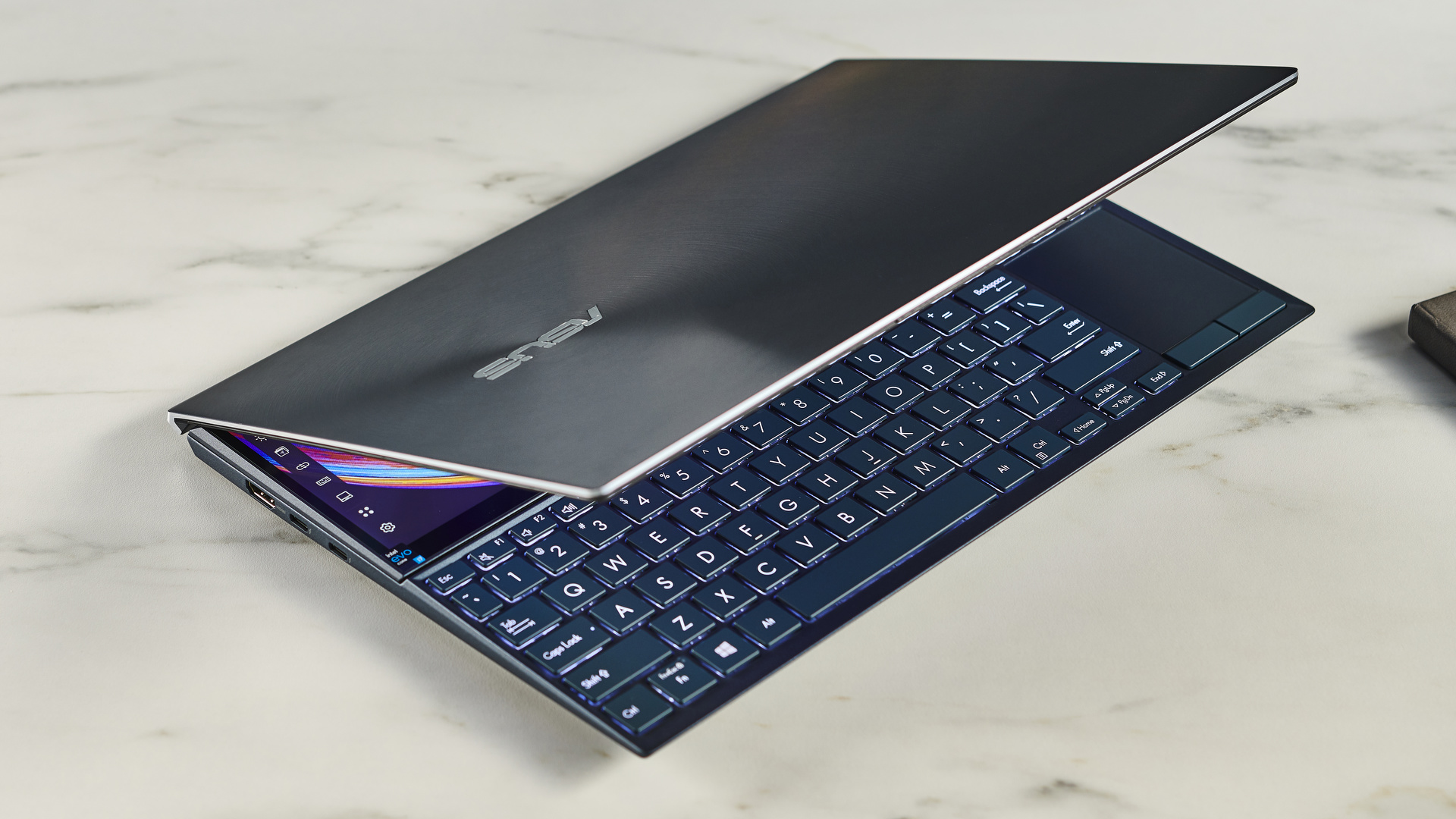
Here is the Asus ZenBook Duo 14 UX482E configuration sent to TechRadar for review:
CPU: 2.8GHz Intel Core i7-1165G7 (4-core, 12MB Cache, up to 4.7GHz with Turbo Boost)
Graphics: Intel Iris Xe Graphics
RAM: 32GB LPDDR4X
Screen: 14-inch FHD (1,920 x 1,080) IPS touch, 12.65-inch (1,920 x 515) ScreenPad Plus
Storage: 1TB SSD (PCIe, NVMe, M.2)
Ports: 2x USB-C with Thunderbolt 4, 2 x USB-C 3.1, 1 x microSD card reader, combi audio jack
Connectivity: Wi-Fi 6, Bluetooth 5.0
Camera: HD webcam
Weight: 3.57 pounds (1.62 kg)
Size: 12.76 x 8.74 x 0.67 inches (32.40 x 22.20 x 1.69 cm; W x D x H)
Price and availability
In the US and the UK, the new Asus ZenBook Duo 14 is available in two configurations, but they're quite different.
In the US, the base model comes with an Intel Core i5-1135G7 processor, 8GB of RAM and a 512GB SSD for $999.99.
There’s also a higher-end model with an Intel Core i7-1165G7, 8GB of RAM and a 512GB SSD for $1,299.99. Both these prices do not include tax.
In the UK, there doesn’t seem to be an i5 model right now. The base model comes with an Intel Core i7-1165G7 processor, Nvidia MX450 graphics card, 16GB of RAM and 512GB SSD for £1,499. That’s quite a lot more powerful than the base model in the US, and with double the RAM and a discrete GPU, it means it’s a more capable machine for video editing, for example.
A higher-end model delivers the same spec, but doubles the RAM to 32GB and the storage space to 1TB for £1,699. This model will only be of interest to people looking to do some serious media creation on the laptop. So, it’s a bit odd that if you’re in the US, you may not be able to get this model. Meanwhile, in the UK, if you want to save money with a lower-specced i5 machine, you’re out of luck.
In addition, at the time of writing we didn't have Australian prices or availability. We’ll update this review as soon as we hear back.
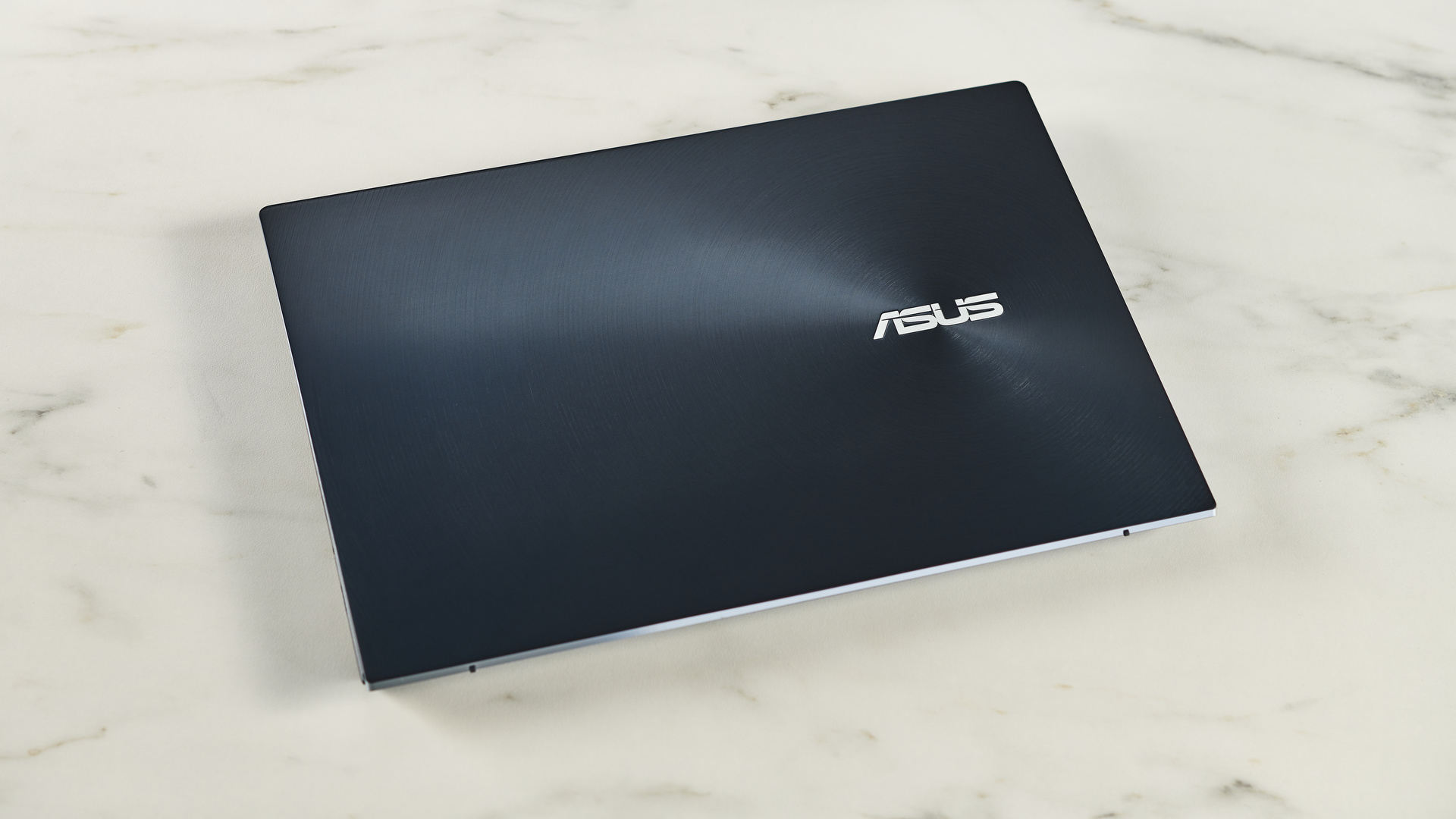
Design
The most remarkable aspect of the Asus ZenBook Duo 14 UX482E’s design is the second screen, but we’ll get to that in a moment.
On first taking the Asus ZenBook Duo 14 UX482E out of the box, you wouldn’t think that it packed a second screen. It looks like a premium thin and light Ultrabook, which will please anyone worried that the second screen would lead to a bulky device.
With dimensions of 12.76 x 8.74 x 0.68 inches (32.40 x 22.20 x 1.69cm) and a weight of 1.62kg, this is a 14-inch laptop that you should find pretty easy to carry around. It sports the brushed metal finish we’ve seen on other ZenBooks – and, once again, it results in a laptop that feels both premium and sturdy.
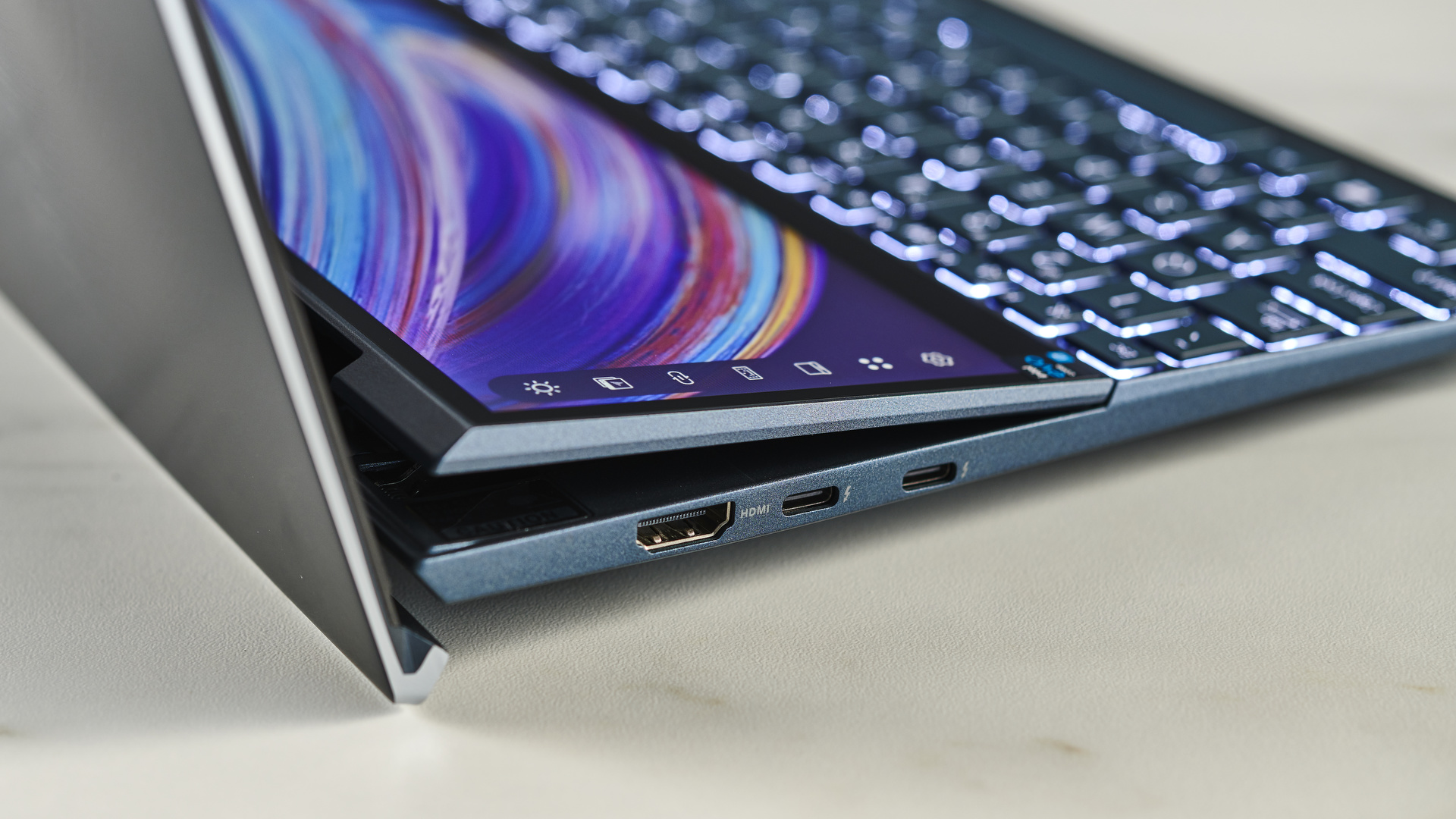
In terms of connectivity, the Asus ZenBook Duo 14 UX482E offers a decent selection of ports for a machine that is productivity focussed. On the left sit two USB-C ports, which can be used to charge the laptop, and a full-size HDMI port. On the right is a USB-A port, audio jack and microSD card slot. That last one is a welcome inclusion, and will prove a particularly handy addition for digital creatives.
Of course, open up the Asus ZenBook Duo 14 UX482E, and its unique design will be revealed.
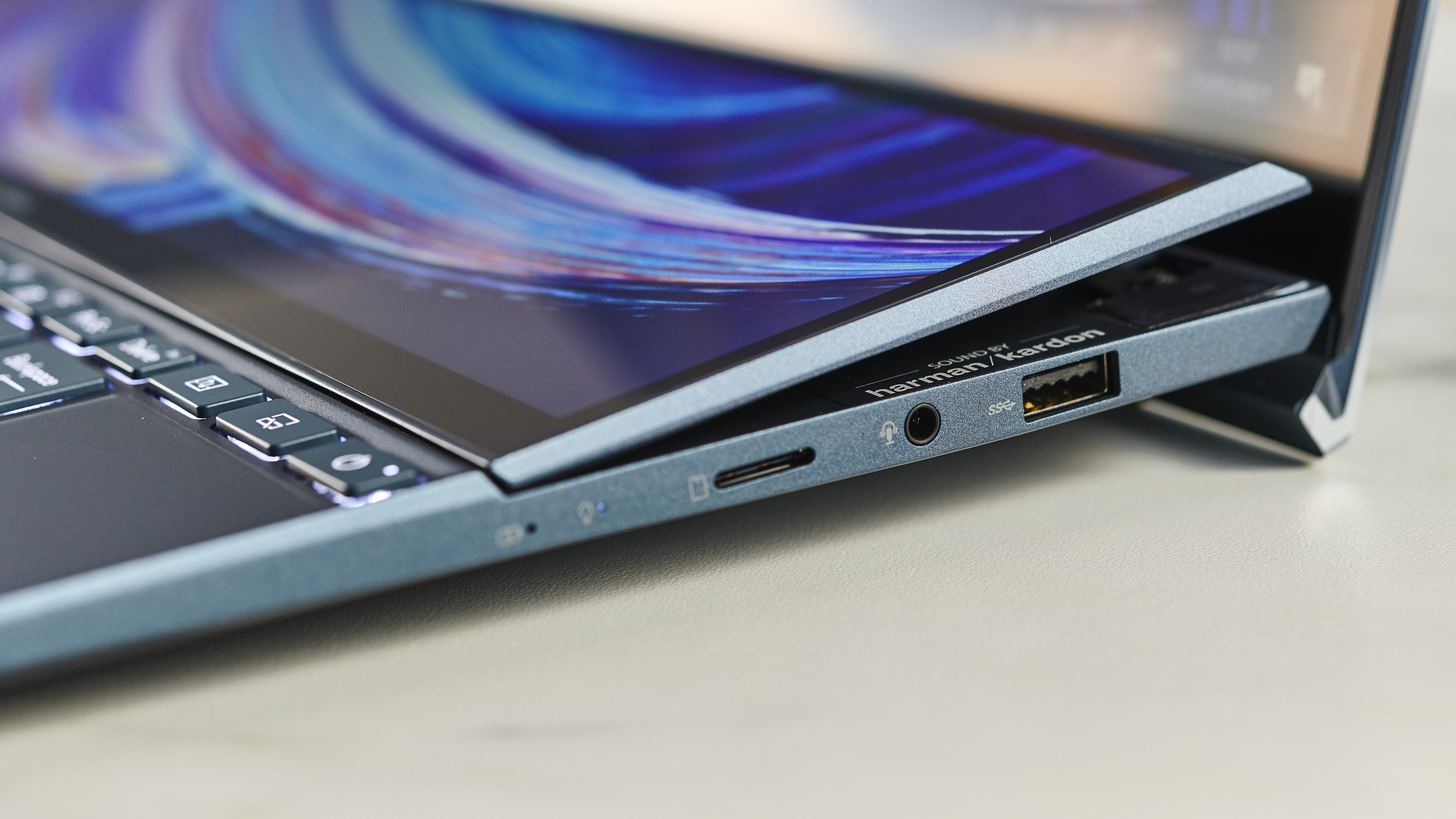
The second screen, known as the ScreenPad Plus, sits directly below the main screen. It's a 12.65-inch touchscreen with a 1,920 x 515 resolution and stylus support. Sadly, a stylus isn’t included.
The IPS panel is bright and vibrant, and means that the second screen doesn’t feel like a second thought. The ScreenPad on earlier ZenBook Duos didn't appear as bright or vibrant as the main screen. Thankfully, there aren't any such visual discrepancies here.
Since the ScreenPadPlus sits just below the main screen, it means that once again the keyboard is brought forward to the bottom of the lower half of the laptop. This will take some getting used to, and more immediately means that there's no place on the laptop to rest your wrists while typing. On traditional laptops, you can use the body of the laptop below the keyboard.
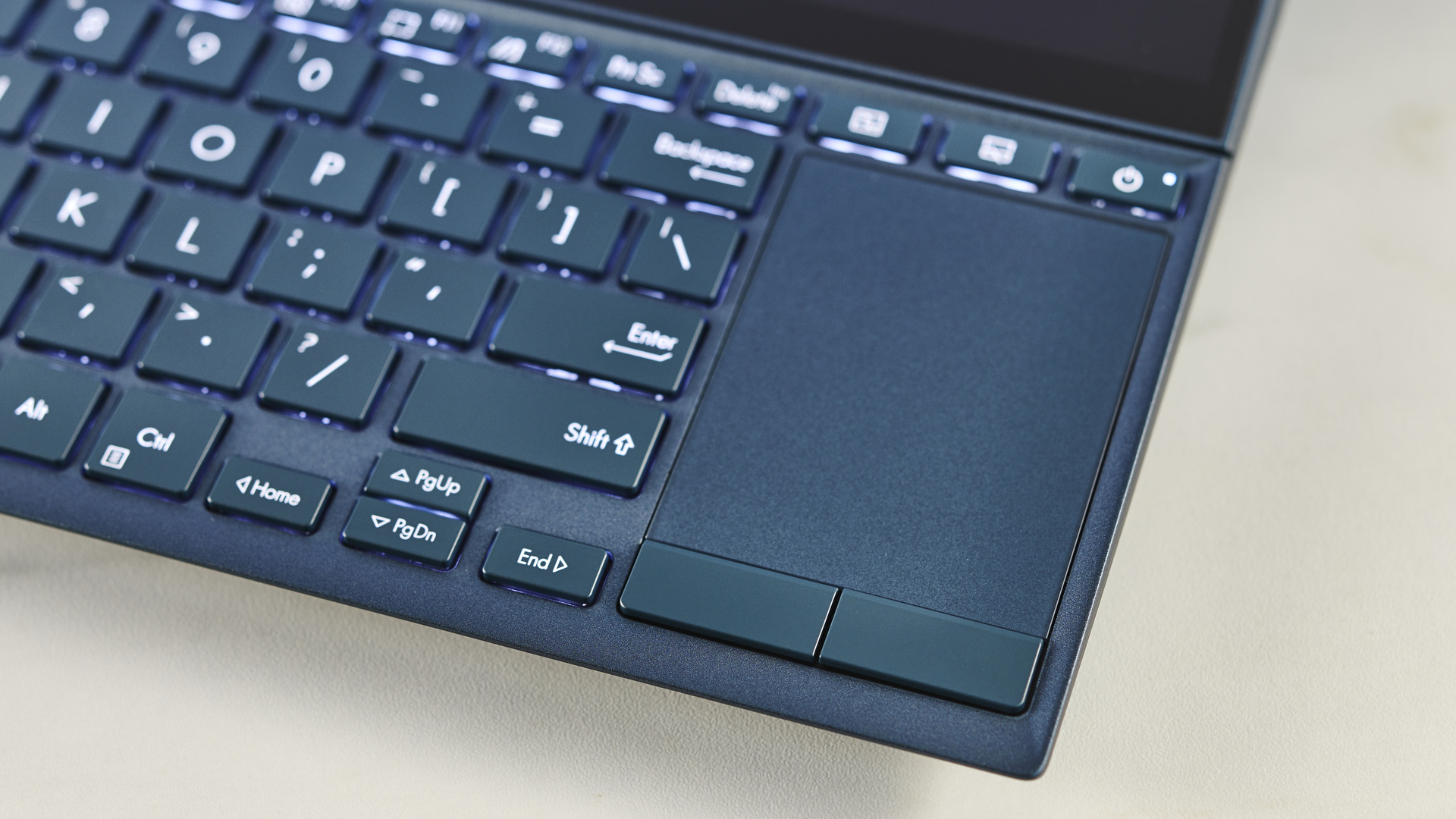
If you're working at a desk then you could use a separate wrist rest, but it makes working on your lap more uncomfortable. If you’re looking for a laptop to type on while seated on your sofa, this isn’t it.
The keyboard features two extra buttons above the touchpad that relate to the ScreenPad Plus. The first one quickly swaps content between the main screen and the second one. This is handy if you want to bring an open window from the main screen to the ScreenPad Plus. A quick tap of this button does that, and resizes the windows to display on the smaller display.
The second button disables the ScreenPad Plus, which is useful if you want to preserve battery; or, if you’re not using the second screen and don’t want to be distracted by it (or accidentally tap on it).
As with previous ZenBook Duo laptops, the touchpad is shifted from its traditional location below the keyboard to the right-hand side. Again, this takes some getting used to. For left-handed people, in particular, it will be difficult to use. The touchpad is also taller and narrower than those found on standard laptops, which limits your movement.
However, by tapping three fingers on the ScreenPad Plus, it turns it into a big touchpad, providing greater freedom when controlling the laptop.
Nevertheless, the majority of people will likely end up using an external mouse – but, again, this means the Asus ZenBook Duo 14 UX482E feels like a laptop that’s better suited to being used on a desk.
One rather nice feature is that when you open up the Asus ZenBook Duo 14 UX482E, the ScreenPadPlus lifts up slightly on its ‘ErgoLift’ hinge. Not only does this make the second screen more comfortable to view, but it allows for better airflow (Asus claims a boost of 49%), allowing the powerful components inside the laptop to remain cool.
Two fans inside the laptop, plus a large bore heatpipe, are also on heat-dissipating duties. As such, it shouldn’t be an issue, no matter how hard you push the laptop.
As for the main screen, this is a 14-inch 1080p IPS touchscreen. The bezels around the screen are pleasingly thin, with Asus claiming a screen-to-body ratio of 93%. This gives the laptop a modern feel, and keeps its size down.
Overall, the Asus ZenBook Duo 14 UX482E's design is one of its key selling points, but there's no doubt that some aspects will be divisive.
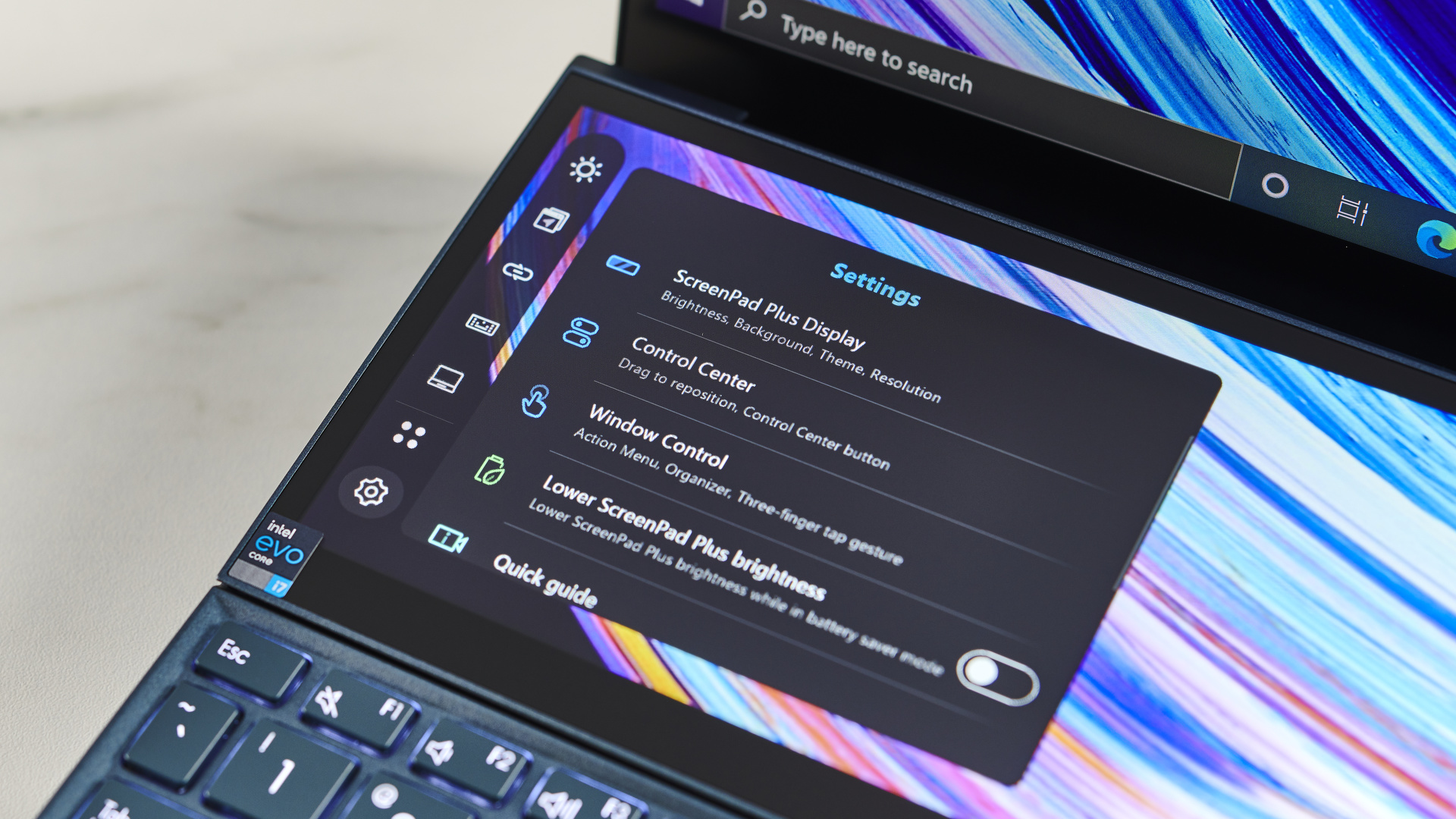
Here’s how the Asus ZenBook Duo 14 UX482E performed in our suite of benchmark tests:
Cinebench R20 CPU: 1,746 points
3DMark Time Spy: 1,740; Fire Strike: 4,824; Night Raid: 15,062
GeekBench 5: 1,485 (single-core); 5,153 (multi-core)
PCMark 10 (Home Test): 5,016 points
PCMark 10 Battery Life: 10 hours 44 minutes
Battery Life (TechRadar movie test): 11 hours 50 minutes
Performance
The Asus ZenBook Duo 14 UX482E is Intel Evo certified, which means it has to offer specific features. As with Project Athena and Ultrabooks before it, Intel Evo highlights laptops that come with premium components and features; the idea being that if you buy an Intel Evo laptop, you’re guaranteed to get a certain level of performance.
So, the Asus ZenBook Duo 14 UX482E comes with an 11th-generation Intel Core processor (a choice of either an Intel Core i7-1165G or Intel Core i5-1135G7), Intel Iris X graphics and Thunderbolt 4 connectivity.
Intel Evo laptops must also have thin bezels around the screen, Wi-Fi 6, offer over nine hours of battery life, and wake up in less than a second.
Intel is serious about the Evo label being a mark of quality for laptops, and Asus definitely appears to respect that. As we covered in the design section of the review, the Asus ZenBook Duo 14 UX482E looks and feels like a premium laptop, and the good news is that it delivees performance to match. Windows 10 boots up fast, and it runs smoothly as well.
In our time with the Asus ZenBook Duo 14 UX482E, we loaded several apps at once, did a lot of web browsing and a spot of media streaming – throughout the laptop performed brilliantly.
The fans were noticeably loud, though. A dual-fan design to keeps the components cool, along with a body that opens up to allow for better cooling, mean this laptop can get noisy. However, the cooling tech allows the laptop to work at speed for long periods of time without throttling performance.
So in order to get sustained performance with the Asus ZenBook Duo 14 UX482E, you’ll have to make do with fan noise.
As for the second screen, Asus has done a lot of work to ensure it's a useful addition. Better integration with apps such as Photoshop and Lightroom make it a genuinely decent tool if you regularly use those applications.
It also features an overhauled user interface with the ScreenXpert 2 software. A menu runs down the left-hand side for quick access to settings and tools, and overall configurability is increased, so it’s easier to set the ScreenPad Plus to work the way you want it to.
Asus also told us that it was working with other third-party app makers to bring greater support for the ScreenPad Plus. Both this, and the configurability, are essential to ensuring the second screen enhances the Asus ZenBook Duo 14 UX482E's user experience.
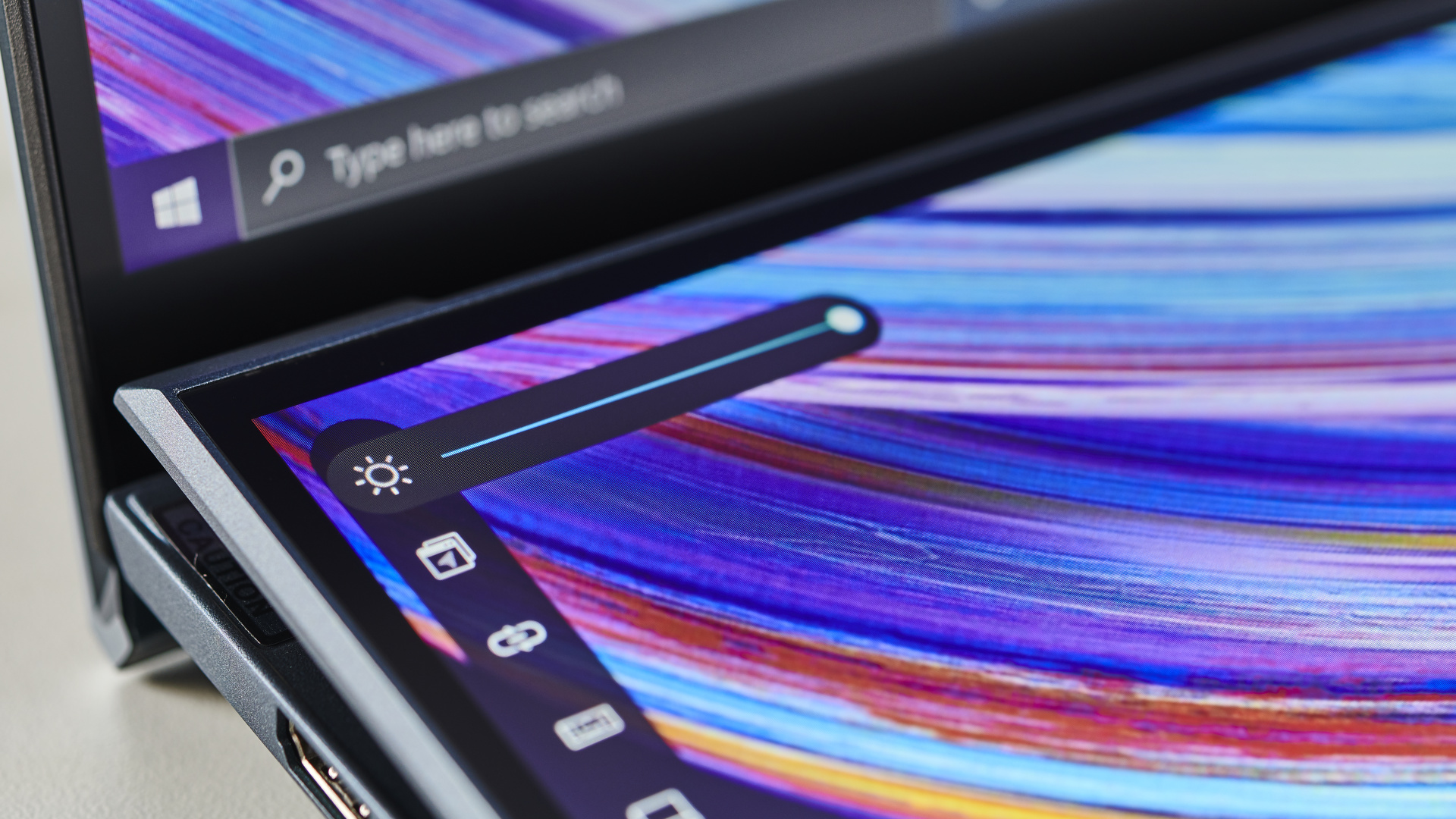
Overall, the Asus ZenBook Duo 14 UX482E’s second screen is more than just a gimmick. While we’ve been dubious of its use in the past, to be fair to Asus, the company has been working hard to ensure it's an excellent tool, especially for use with creative apps.
However, one thing that continues to annoy is that, on occasion, windows can end up straddling the bottom screen, hiding buttons or links, which can be frustrating.
In the end, though, the Asus ZenBook Duo 14 UX482E offers an excellent all-round laptop experience. Windows 10 is fast and responsive, and creative apps not only benefit from the extra horsepower this new model provides, but the ScreenPad Plus is becoming an ever more impressive tool. If Asus continues to work with app creators to add better support, it could become a true selling point. Right now, however, regular users may still struggle to see the appeal.
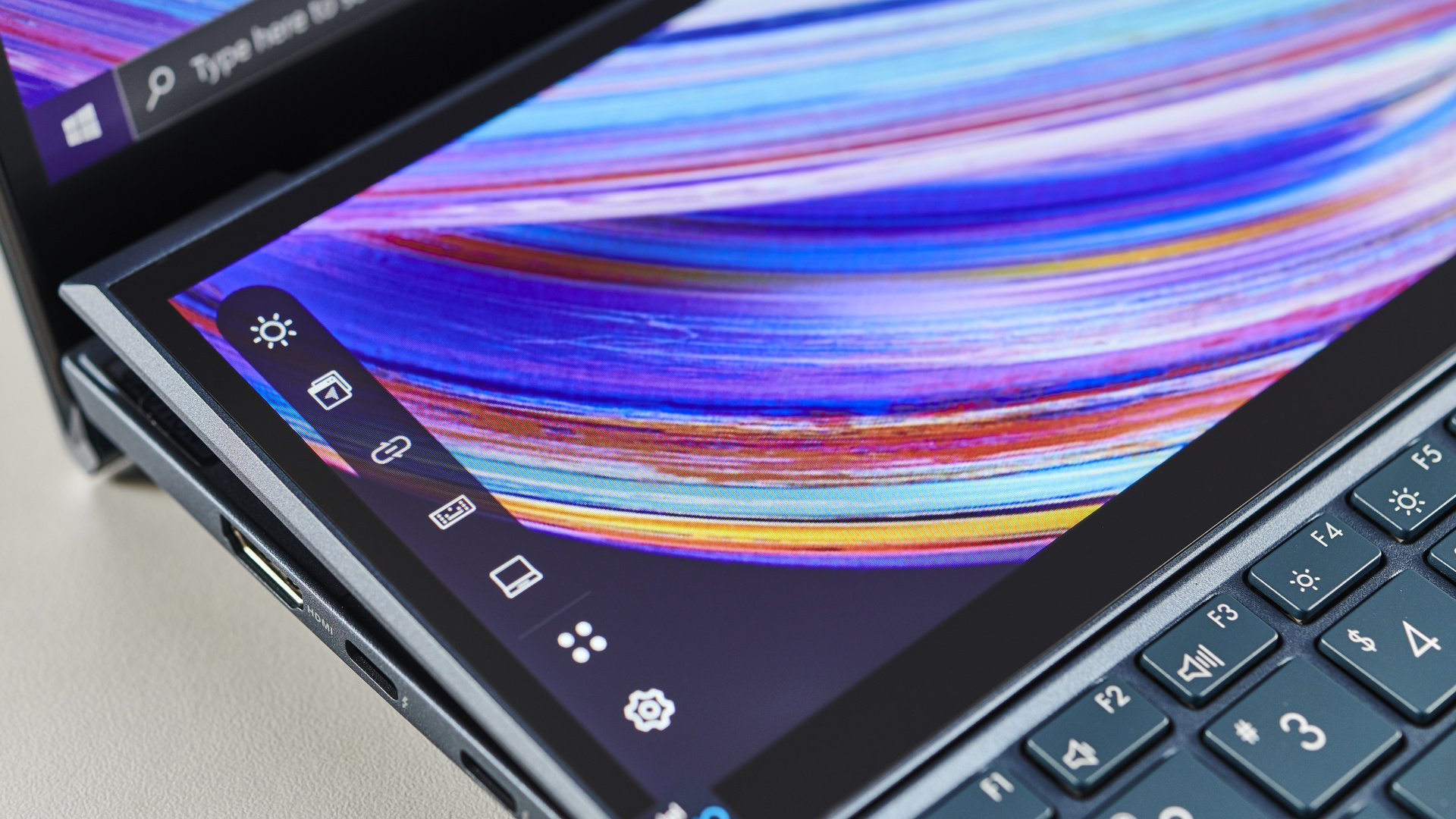
Battery life
One of the most important considerations for people looking for a new laptop is battery life. Consumers are expecting ever longer times between charges, which can pose a challenge when they also expect laptops to deliver for power, too.
As mentioned earlier, in order to bear the Intel Evo stamp, the Asus ZenBook Duo 14 UX482E needs to offer over nine hours of battery life. The good news is that it quite easily surpasses that.
In our battery tests, where we ran a looped video at 50% brightness, the Asus ZenBook Duo 14 UX482E lasted a pretty impressive 11 hours and 50 minutes.
Considering the power and additional screen, that’s a brilliant achievement, far exceeding the battery life of earlier dual-screen laptops such as the Asus ZenBook Pro Duo UX581, which only managed five hours.
Meanwhile, in the PCMark 10 benchmark, which replicates day-to-day use, the Asus ZenBook Duo 14 UX482E scored an excellent 10 hours and 44 minutes. This is a significant improvement over the Asus ZenBook Pro Duo UX581’s shocking score of just two and a half hours in the similar PCMark 8 battery benchmark.
The above figure clearly show that Asus has done a brilliant job of improving the battery life of its dual-screen laptops, and it’s certainly helped by the inclusion of Intel’s more efficient 11th-generation mobile processors.
It’s also worth noting that we ran all battery benchmarks with the second screen on – so you don’t need to worry about sacrificing battery life for the extra screen.
In our day-to-day use, the Asus ZenBook Duo 14 UX482E did a great job of keeping hold of battery life throughout the day. So, unless you’re doing some very heavy-duty video editing or similar, this laptop should happily last a whole work day without too much trouble. For a powerful dual-screen laptop, that’s damn impressive.
Buy it if...
One screen isn’t enough
The Asus ZenBook Duo 14 UX482E’s main selling point is that second screen, so if you spend a lot of time working on a laptop, but find one screen too cramped, you'll love this device.
You want a powerful laptop for content creation
Content creators will love the Asus ZenBook Duo 14 UX482E’s power, beautiful screen, and even the second screen, which can display tools from Photoshop and other apps.
You want a workstation that doesn't need to be plugged in
The Asus ZenBook Duo 14 UX482E’s awesome battery life, combined with its powerful performance, could prove to be a real game changer.
Don't buy it if...
One screen is enough
For the majority, a traditional laptop with a single screen is perfectly fine. If you’ve never had the need for a second screen, you don’t need the Asus ZenBook Duo 14 UX482E.
You want a couch laptop
Want a laptop you can use comfortably on your lap? This isn’t it. Due to the placement of the keyboard, this laptop is better used on a desk with a wrist rest.
You want to play games
Despite the powerful components, this isn't a gaming laptop. If you like the sound of the dual screens and want a gaming machine, check out Asus’ Zephyrus Duo 15 instead.
- These are the best laptops of 2020

Matt is TechRadar's Managing Editor for Core Tech, looking after computing and mobile technology. Having written for a number of publications such as PC Plus, PC Format, T3 and Linux Format, there's no aspect of technology that Matt isn't passionate about, especially computing and PC gaming. He’s personally reviewed and used most of the laptops in our best laptops guide - and since joining TechRadar in 2014, he's reviewed over 250 laptops and computing accessories personally.
